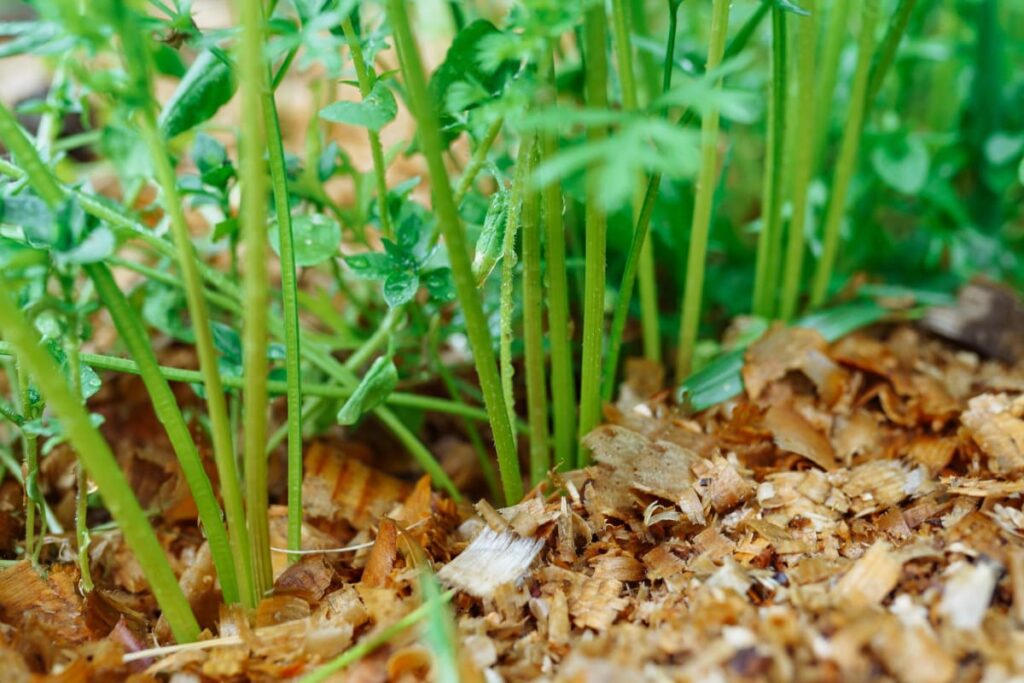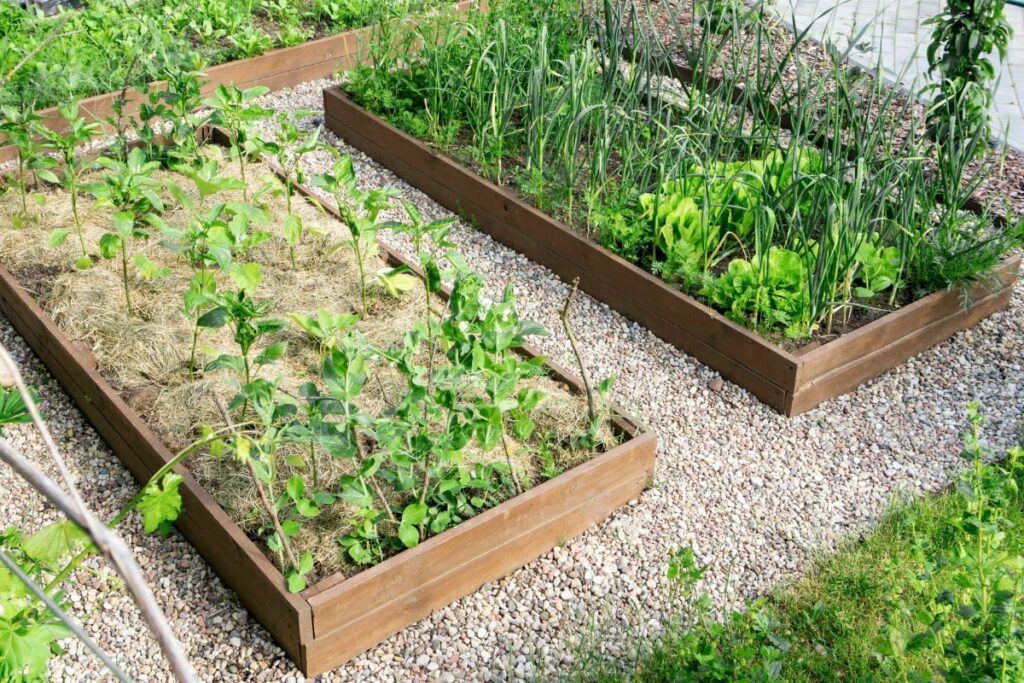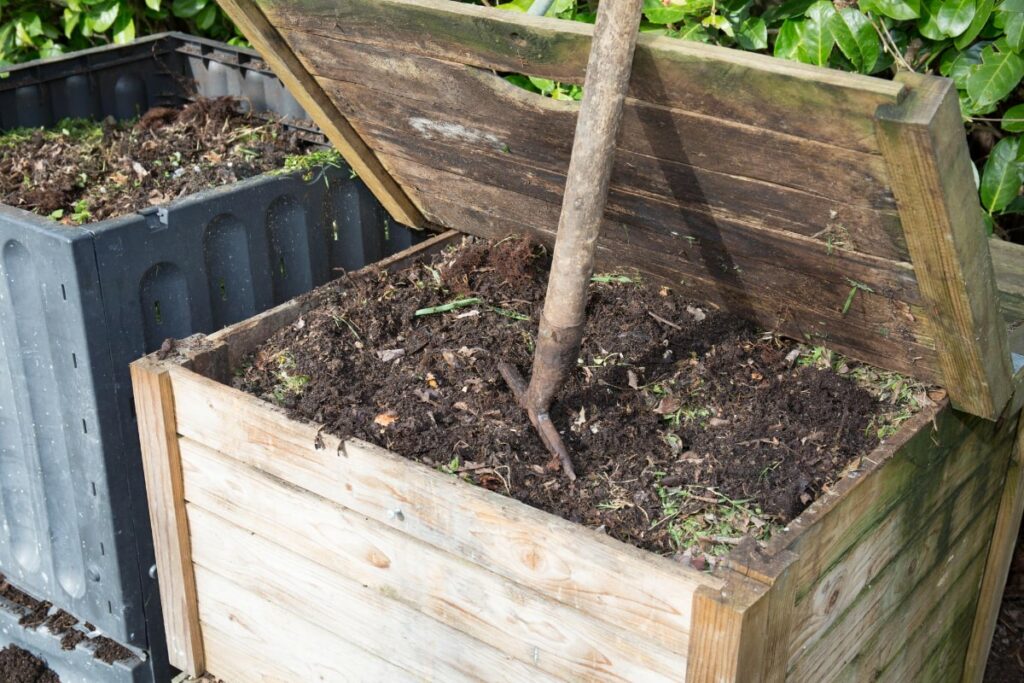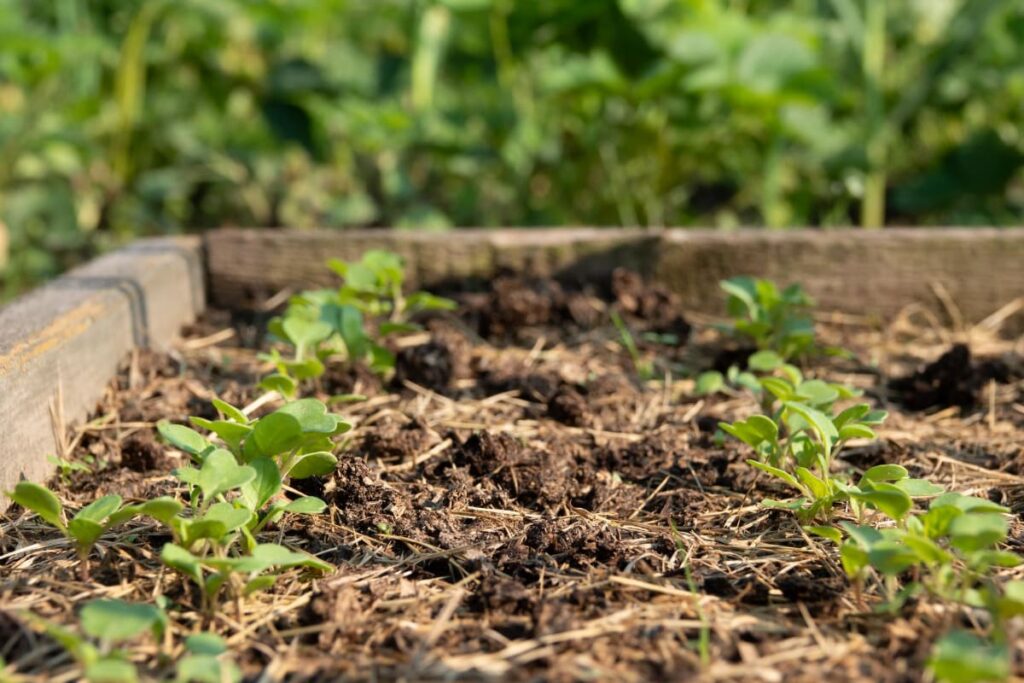Mulching is an important part of vegetable gardening. Not only does it help prevent weeds from growing, it helps retain moisture and nutrients in the soil. This means your plants will grow bigger and healthier.
In this article, I’ll teach you how to mulch your vegetable garden properly using a variety of materials, like compost, straw, leaves, wood chips, hay, grass clippings, and bark.
I’ll cover the top benefits of mulching along with my top tips when it comes to mulching a vegetable garden.

Can You Use Mulch in a Vegetable Garden?
Mulch can be used very effectively in a vegetable garden, and will benefit both the plants and the soil. Many different types of mulch can be used, but as most of your vegetables will be annual, it’s best to use a mulch that will break down very quickly and add to the organic content of the soil.
Proponents of the no-dig method use mulch exclusively in vegetable gardens, instead of digging organic materials into the soil. The no-dig method has been known to improve the structure and content of the earth, as well as prevent weeds.
Benefits Of Mulching a Vegetable Garden
All vegetable gardens, even ones grown in pots, will benefit from a layer of mulch. Below I’ve listed the top five benefits of mulching vegetable gardens.
- Weed suppression is the number one reason to mulch your vegetable patch. Weeds can steal valuable nutrients from the soil, and pulling them out can be a never-ending task. In this way, mulching can reduce the work you have to do in the garden and help eliminate competition for nutrients.
- Moisture retention is another great benefit of mulching, especially if you dread watering the whole garden! Mulching can trap moisture in the soil, meaning you don’t have to water as frequently. If you are growing in pots, putting a layer of mulch on the top can mean the soil won’t dry out completely during particularly hot days.
- Adding nutrients. The most commonly used mulch for vegetable gardens is compost, which adds nutrients to the soil and reduces the need for fertilizer. Some heavy-feeding plants may still need a bit of a boost while fruiting, but with a good layer of compost, most vegetables already have what they need.
- Improving soil condition. Adding layers of mulch made from organic material each year will improve the soil’s condition over the years. Industrial farming methods that involve tilling the ground and using chemical fertilizers can actually damage the soil over time, leading to erosion and “dead” unproductive soil.
By adding compost mulch, you are improving and adding to the layer of topsoil on which all living things depend. - Improving the ecosystem of your soil. Good compost and good soil contain a delicate ecosystem of microorganisms, invertebrates, and insects. By mulching compost rather than digging it in, the balance of the soil is maintained and left undisturbed.

What is the Best Mulch For a Vegetable Garden?
- Compost – As previously mentioned, compost is the best material for mulching. But not all compost is made equally, and well-rotted organic that has been composted using the hot-composting method will be the most desirable one to use. Hot composting is better than cold composting for mulch because any seeds and pathogens will be killed off during the process.
- Straw – Straw is also a great material to use for mulching vegetable gardens. It keeps the soil cool in summer, warm in winter, casts shade that prevents weed seedlings, and retains moisture. It breaks down quickly, and adds nutrients and organic material to the soil.
The only downsides to using straw is that it can spread a fungus to your crops if it is placed too close to the stem or leaves of your plant. And it provides an excellent cover for mice to access your crops. - Wood or Bark Chippings – This material is not ideal for in-between vegetables as it can take a long time to mulch and absorbs nitrogen when it breaks down. However, they are perfect for paths as they prevent soil compaction and do suppress weeds. That being said, you can use wood or bark chips around perennials like gooseberry, raspberry, asparagus, and rhubarb.
- Fresh Grass Clippings – The truly great thing about this mulch is that it is readily available in the summer. Even if you don’t have grass in your yard, the chances are that someone in your neighborhood mows their lawn regularly and will happily let you take the clippings away.
Grass clippings can be applied throughout the summer. They will suppress weeds (as long as the grass cut has not yet gone to seed), retain moisture, and break down quickly, adding nutrients to the soil. - Living Mulch – Living mulch has all the benefits of the other mulch and can attract pollinators to your vegetable patch. The oldest known use of living mulch was by Native Americans when they used squash as a ground cover when planting the Three Sisters.
Some other great mulches for vegetable gardens are clover (which fixes low nitrogen), low-growing aromatic herbs like creeping thyme that attracts wildlife, and chickweed, which attracts pollinators and is edible.

How to Mulch a Vegetable Garden
There are many kinds of mulch, so the ways of applying them can vary. Below I’ve listed the general steps to mulching a garden.
- Clear the area of weeds. If there are any deep-rooted annuals like brambles or bindweed, then pull out as much of the root as you can.
- Level out the surface with a rake to get rid of any dips or bumps. You can then firm up the soil a little by walking over it if you need to.
- Thoroughly water the area to make sure the soil is moist when you apply the mulch.
- Apply the mulch. Using a spade, trowel, or just your hands, apply around a 5 cm layer of your chosen mulch. 5 cm should be sufficient to suppress most weeds, but some unwanted plants with deep roots may still break through. As long as you pull them out as soon as you see them, you should be able to keep them at bay long enough for them to die off.
When To Mulch Your Vegetable Garden
The best time of year to apply mulch is in the fall to prepare your beds for the following year. Another great time to mulch is in the spring when the soil is moist and starting to warm up. By mulching at these times, you can add a good layer of mulch when your vegetable beds are pretty much empty.

Tips for Using Mulch in a Vegetable Garden
After 10+ years of mulching my vegetable garden, these are the top tips I’ve learned from my experiences.
- Use organic matter that will break down quickly and improve the soil.
- Water BEFORE you add mulch.
- When you mulch in the autumn, you can put a layer of cardboard over it. This layer will protect the soil from heavy rain and frost, as well as help suppress any weed growth. Then, when you mulch in spring, you can layer your mulch on top of the cardboard.
- Ensure your compost mulch is weed-free by keeping your compost heap covered in a piece of old carpet. Not only does this keep the heat (and the smell) in, it will keep out any wind-borne seeds, so nothing new grows in the pile.
Mulching a Vegetable Garden Final Thoughts
Mulching is an easy way to manage a vegetable garden without having to spend hours every week weeding. It’s also a cheap method that doesn’t require a lot of effort.
If you’re looking for more information on how to grow vegetables, check out these articles:

